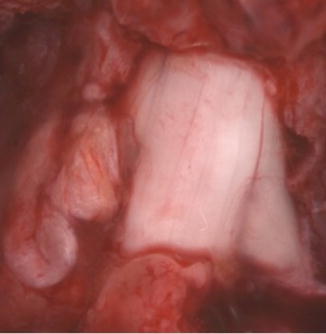Fig. 60.1
The epineurium of the removed sciatic nerve segment after it has been incised longitudinally and the fascicles, endoneurium, and perineurium were removed
Epineural Sheath Naïve Control
Bilateral epineural sheaths of are harvested according to the method described above and served as a control for immunohistochemical analysis and to assess the level of gene expression of Vegfa using Taqman real-time PCR.
Application of the Epineural Sheath as a Neuroprotective Patch Following Lumbar Laminectomy
Experimental Model
Using a modified lumbar radiculopathy model, originally described by Kawakami et al. bilateral L4–L6 levels are exposed, a left-sided L5 hemilaminectomy is performed, and the lumbar root and DRG of the left L5 nerve root is carefully exposed [7]. Care is taken to ensure that the contralateral L5 DRG remained undisturbed. This contralateral L5 DRG would serve as an internal control.
Study Groups
Group I, the laminectomy–only group, where a left-sided L5 hemilaminectomy and DRG exposure is followed by standard closing procedure, without application of the epineural sheath. Six animals per group are sacrificed at 24 h, 72 h, and 7 days post-surgery and had their bilateral L5 DRG harvested for analysis.
Group II, the experimental group, where a left-sided L5 hemilaminectomy and DRG exposure is followed by topical application of a 4 × 4 mm sheath of epineurium onto the DRG, this sheath functioned as a topical patch covering the dorsal surface of the DRG (Fig. 60.2).


Fig. 60.2
Exposed L5 DRG covered with epineural sheath. The exposed contralateral DRG serves as an internal control
This is followed by a standard closing procedure. Six animals per group are sacrificed at 24 h, 72 h, and 7 days post-surgery and had their bilateral L5 DRG harvested for analysis. The animals are evaluated on a daily basis for the presence of distress, discomfort, or weight loss according to our animal care protocol.
Assessment of Immunological and Neuroregenerative Properties of the Harvested Naïve Epineural Sheath
Epineural Sheath Staining for Immunofluorescence with VEGF, GFAP, vWF, NGF, Laminin, MHC Class I, MHC Class II, CD45, CD3 and S100
Freshly dissected nerve sheaths from bilateral sciatic nerves of naïve Lewis rats are snap-frozen in liquid nitrogen. Prior to immunostaining, tissue slides are cut for 5 μm slides and fixed for 10 min. in cold acetone. Next, sections are rinsed in TBS buffer (Dako) and incubated with mouse anti-rat VEGF (C1) (Santa Cruz Biotechnology, Inc), MHC class I (clone B5), MHC class II (clone OX-17), CD45 (OX-1) and CD3 (G4.18) (BD Biosciences, USA) and rabbit polyclonal NGF (H-20) (Santa Cruz Biotechnology, Inc) antibody, mouse anti-rat GFAP (2E1) monoclonal antibody (Santa Cruz Biotechnology, Inc), Laminin (Santa Cruz Biotechnology, Inc) for 30 min. The binding of primary antibodies is detected using the immunofluorescence method with rabbit anti-mouse immunoglobulin /FITC (DAKO, Carpinteria, CA, USA) and polyclonal swine anti-rabbit immunoglobulin /FITC (DAKO, Carpinteria, CA, USA) in accordance with the manufacturer’s instructions. Slides are mounted in Vectashield mounting medium with DAPI for fluorescence and analyzed using fluorescence microscope by two examiners blinded when assessing the intensity of staining.
Assessment of Proangiogenic and Neuroregenerative Properties of the Epineural Sheath Applied as a Patch Following Lumbar Laminectomy (Experimental Group II)
Preparation of Paraffin Sections for VEGF, vWF, GFAP, NGF, S100 and Laminin Histoimmunostaining
Stay updated, free articles. Join our Telegram channel

Full access? Get Clinical Tree








